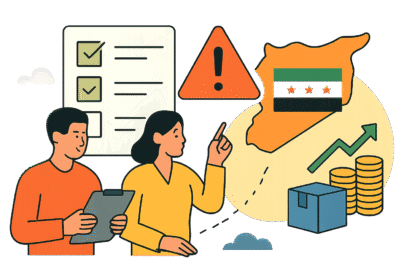
Field Risk Assessment in Syria: A Practical Approach to Protecting Your Investment
- Understanding non-financial risks is the cornerstone of success in the Syrian market.
- Field risk assessment should include all social and logistical aspects.
- It is essential to build strong relationships with local communities and stakeholders.
- Mitigation strategies must be comprehensive and tailored to each situation.
- Continuous monitoring is an essential part of risk assessment in a changing environment.
Table of Contents
- Understanding Non-Financial Risks: A Cornerstone for Success in the Syrian Market
- 1. Operational Risks
- 2. Social Risks
- 3. Logistical Risks
- Insight Syria’s Methodology for Field Risk Assessment
- Case Studies and Real-Life Examples
- Why Insight Syria?
- Conclusion
Understanding Non-Financial Risks: A Cornerstone for Success in the Syrian Market
When we talk about “market entry” in Syria, it is not just about launching a product or service, but about integrating into a complex social and economic fabric. Non-financial risks can manifest in various forms, each requiring a specific handling strategy:
1. Operational Risks
- Lack or instability of infrastructure: Power outages, limited availability of potable water, and difficulty accessing communication and internet networks directly affect operational efficiency.
- Interrupted supply chains: Companies may face difficulties in securing raw materials, spare parts, or even delivery of final products to consumers due to road conditions, customs procedures, or transport restrictions.
- Skilled labor shortage: Finding qualified and adequately trained personnel can be challenging, especially in certain specialized sectors.
- Sudden regulatory changes: The business environment may be affected by changes in laws and regulations, requiring flexibility and quick adaptability.
- Access to working capital: Companies may face challenges in securing the necessary funding to cover operating expenses.
2. Social Risks
- Community tensions: Ethnic, religious, or sectarian differences may affect the work environment or the acceptance of products and services.
- Community acceptance of the project: The project must understand how it will be perceived by local community members, whether it will be deemed beneficial, or whether it raises concerns about employment, environment, or cultural impact.
- Relations with local stakeholders: Building strong and reliable relationships with local leaders, NGOs, and residents is crucial.
- Reputation and brand image: Any cultural or social misunderstanding can negatively affect the company’s reputation.
- Gender-related challenges: In some areas, there may be specific restrictions or expectations regarding women’s participation in the workforce or business activities.
3. Logistical Risks
- Condition of roads and transport networks: Some roads may be impassable or hazardous, affecting speed and efficiency of transport.
- Security procedures at checkpoints: Checkpoints can cause significant delays in the movement of goods and people.
- High transportation costs: Shipping and distribution costs may be higher due to distances, risks, or lack of available transportation means.
- Difficulty in storage and distribution: Companies may face challenges in securing safe warehouses and efficient distribution sites.
- Receipt and delivery: Ensuring that products or materials arrive on time and in good condition requires meticulous logistical planning.
Insight Syria’s Methodology for Field Risk Assessment
At “Insight Syria”, we adopt a comprehensive and step-by-step methodology for conducting Field Risk Assessment in Syria: A Practical Approach to Protecting Your Investment. This methodology ensures that all important aspects are covered and provides our clients with the necessary information to make informed decisions.
Step 1: Defining the Scope and Objectives of the Assessment
The process begins with a deep understanding of the client’s needs and project goals. What type of investment is it? What is the target geographic location? What are the timelines? Through intensive workshops, we precisely determine what needs to be assessed and what are the desired outcomes.
Step 2: Collecting Qualitative and Quantitative Data
This step is the heart of the assessment process. We use a mix of methods to ensure data comprehensiveness and accuracy:
- Direct field surveys: Our team visits target sites, conducts interviews with local residents, local authorities, community leaders, and existing businesses.
- Focus Groups: These sessions allow us to gain deeper insights into the opinions, beliefs, and expectations of target groups.
- Analysis of existing documents and research: We review government reports, academic studies, international organizations’ analyses, and relevant local and international news.
- Targeted questionnaires: We design and administer questionnaires to measure specific trends, acceptance levels, or assess the need for certain products or services.
- Geographic Information System (GIS) Analysis: This technique can be used to analyze distribution patterns, infrastructure, and strategic locations.
- Local source networks: We rely on our extensive network of trusted sources across various Syrian provinces to obtain updated and accurate information.
Step 3: Field Risk Analysis
After data collection, our team of experts analyzes it to identify and measure potential risks. This includes:
- Risk identification: Classifying risks into operational, social, logistical, etc.
- Likelihood assessment: Estimating the probability of each risk occurring.
- Impact assessment: Estimating the extent of damage or loss that could result from the risk (financial, operational, reputational).
- Priority setting: Ranking risks based on a combination of likelihood and impact, focusing on high-priority risks.
Step 4: Developing Mitigation Strategies
Our role is not limited to identifying risks; we assist our clients in formulating practical plans to address them. Mitigation strategies include:
- Insurance: Covering some financial risks through appropriate insurance policies.
- Diversification: Diversifying supply chains, labor sources, or geographic locations to reduce dependency on a single source.
- Adaptation to local culture: Developing products, services, and marketing campaigns that align with local customs and traditions.
- Building strong relationships: Establishing partnerships with reliable local entities, working closely with communities.
- Contingency Planning: Developing alternative plans to deal with emergencies or unexpected disruptions.
- Training and development: Investing in training employees on required skills and dealing with the local work environment.
- Effective communication: Establishing clear communication channels with all stakeholders, including local authorities and communities.
- Choosing the right partners: Ensuring that local partners are reputable and competent.
- Continuous monitoring: Establishing mechanisms to monitor the changing environment and regularly update the risk assessment.
Step 5: Continuous Monitoring and Review
The business environment in Syria is characterized by rapid change. Therefore, Field Risk Assessment in Syria: A Practical Approach to Protecting Your Investment is not a one-time process but an ongoing one. We monitor developments, assess the effectiveness of mitigation strategies, and provide regular updates to our clients to ensure their investments remain safe and capable of growth.
Case Studies and Real-Life Examples
To provide a clearer picture, let’s review some hypothetical examples of how our methodology is applied:
Example 1: A food company seeking to enter the Damascus market
- Analysis: Our field research showed a strong demand for sterilized dairy products, but supply chains for raw milk could be interrupted due to weather conditions and certain checkpoints. We also found consumer concerns about the use of preservatives and the importance of health certifications.
- Mitigation strategies:
- Operational: Establishing direct relationships with several farms in different areas to ensure continuous supply, using refrigerated transport with secured special permits.
- Social: Launching a marketing campaign focused on “Nature’s Health” and “Preservative-Free”, highlighting quality certifications issued by recognized entities.
- Logistical: Building a central modern warehouse in an easily accessible location, and training a specialized distribution team.
Example 2: A tech company offering educational solutions in Aleppo
- Analysis: The field assessment revealed significant disparities in internet infrastructure between areas. Some schools struggle with a lack of devices, and there is an acute need for training teachers on using new technologies. Additionally, we faced challenges in obtaining certain licenses from local administrations.
- Mitigation strategies:
- Operational: Providing educational solutions that can operate even with low internet speeds, and developing teacher training programs in collaboration with the Ministry of Education.
- Social: Organizing free introductory workshops for teachers and parents to demonstrate the benefits of technological solutions, building trust.
- Logistical: Offering flexible device purchasing options, or rental models, in collaboration with local financing entities.
- Administrative: Working closely with concerned local authorities to provide all necessary information and facilitate licensing procedures.
Why “Insight Syria”?
At “Insight Syria”, we combine deep expertise in the Syrian market, modern research methodologies, and a precise understanding of non-financial risks. Our team consists of local and international experts with decades of experience in:
- Market analysis: Understanding the dynamics of supply and demand, consumer behavior, and the competitive landscape.
- Field data collection: Designing and implementing reliable and comprehensive data collection tools, adhering to the highest quality standards.
- Big Data Analytics: Extracting valuable insights from large datasets using advanced statistical and analytical tools.
- Social and political research: Understanding the social and political context affecting the business environment.
- Risk management: Developing practical strategies to handle challenges and minimize potential losses.
- Market entry: Providing comprehensive consultations to help companies successfully plan and execute market entry operations.
We recognize that every investment project in Syria has its unique characteristics. Therefore, we do not offer ready-made solutions, but design our services to meet the specific needs of each client. Through our partnership, you can be assured that Field Risk Assessment in Syria: A Practical Approach to Protecting Your Investment is conducted professionally, giving you the confidence needed to make informed decisions.
Conclusion
Entering the Syrian market requires more than just a strong marketing strategy and sufficient capital. It requires a deep understanding of the complexities of the field environment, including operational, social, and logistical risks. These risks, if ignored, can undermine any investment, no matter how promising.
At “Insight Syria”, we offer you the trusted partner that helps you in Field Risk Assessment in Syria: A Practical Approach to Protecting Your Investment. Through our comprehensive methodology, which combines precise data collection, in-depth analysis, and effective mitigation strategy development, we ensure you a clear picture of the landscape, enabling you to make strategic decisions that reduce risks and enhance success opportunities.
We are committed to providing valuable insights that support the growth of your business in Syria. Let “Insight Syria” be your guide in this promising and complex market. Our partnership is your investment in a safe and sustainable future.


